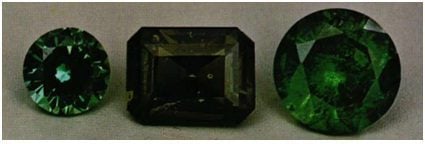Kornerupine Value, Price, and Jewelry Information
Star kornerupine also has been found (Mogok, Myanmar) but is very rare. Kornerupine is generally dark brown or green and not very attractive due to the somber colors. The light green material from Kenya is much more appealing, but the sizes are always small (under 3 carats as a rule). The color is caused by traces of Fe, Cr. and V. Despite the fact that many stones are in museums and private collections, kornerupine is a rather rare gemstone and, for the collector, worth acquiring when available.
1 Minute Read
Star kornerupine also has been found (Mogok, Myanmar) but is very rare. Kornerupine is generally dark brown or green and not very attractive due to the somber colors. The light green material from Kenya is much more appealing, but the sizes are always small (under 3 carats as a rule). The color is caused by traces of Fe, Cr. and V. Despite the fact that many stones are in museums and private collections, kornerupine is a rather rare gemstone and, for the collector, worth acquiring when available.
Start an IGS Membership today
for full access to our price guide (updated monthly).Kornerupine Value
Optics: varies with locality:
Locality | a | β | γ | Birefringence | Density |
| Madagascar | 1.661 | 1.673 | 1.674 | 0.013 | 3.28 |
| Sri Lanka | 1.669 | 1.681 | 1.682 | 0.013 | 3.35 |
| catseye | 1.673 | 1.686 | 1.690 | 0.017 | - |
| Germany | 1.675 | 1.687 | 1.687 | 0.014 | 3.37 |
| Natal | 1.682 | 1.696 | 1.699 | 0.017 | 3.45 |
| Greenland | 1.667 | 1.679 | 1.682 | 0.015 | 3.30 |
| East Africa | 1.662 | 1.675 | 1.677 | 0.015 | - |
Biaxial (-), 2V= 3-48°; gems sometimes pseudo-uniaxial.
Inclusions:Zircon, apatite crystals.
Occurrence: First found in Greenland in radiating crystals (not gemmy), later in cuttable fragments.
Finskenaesset, Southwest Greenland: giant crystals up to 23 cm, yielding cabochons and small (up to 2 carats) faceted gems of dark green color.
Weligama gem gravels, Matara district, SriLanka: greenish to dark yellowish-green catseyes. The eye effect is intense. Stones tend to be small, but cabochons over 7 carats have been reported. Also from Matale, yellowbrown and reddish pebbles, in gravels.
Mogok, Burma: greenish-brown material in gem gravels.
Kwale district, Kenya: light green material, some large clean pieces; colored green by vanadium. Tanzania: chrome variety with green color, cuttable.
Gatineau County, Quebec, Canada: large crystals, dark green to greenish yellow.
Itrongahy, Madagascar: large gemmy dark green crystals, also pale aquamarine-blue.
Betroka and Inanakafy, Madagascar: gray to brown prismatic crystals.
Comments: Star kornerupine also has been found I(Mogok, Burma) but is very rare. Kornerupine is generally dark brown or green and not very attractive due to the somber colors. The light green material from Kenya is much more appealing, but the sizes are always small (under 3 carats as a rule). The color is caused by traces of Fe, Cr. and V. Despite the fact that many stones are in museums and private collections, kornerupine is a rather rare gemstone and, for the collector, worth acquiring when available.
Name: After the Danish geologist Kornerup.
Joel E. Arem, Ph.D., FGA
Dr. Joel E. Arem has more than 60 years of experience in the world of gems and minerals. After obtaining his Ph.D. in Mineralogy from Harvard University, he has published numerous books that are still among the most widely used references and guidebooks on crystals, gems and minerals in the world.
Co-founder and President of numerous organizations, Dr. Arem has enjoyed a lifelong career in mineralogy and gemology. He has been a Smithsonian scientist and Curator, a consultant to many well-known companies and institutions, and a prolific author and speaker. Although his main activities have been as a gem cutter and dealer, his focus has always been education. joelarem.com
Related Articles
Black Diamond Value, Price, and Jewelry Information
Chameleon Diamond Value, Price, and Jewelry Information
Gray Diamond Value, Price, and Jewelry Information
Green Diamond Value, Price, and Jewelry Information
Latest Articles
Opal Buying Guide
Amethyst Sources Around the World: The Geological Story Behind These Purple Gemstones
Brazilianite Value, Price, and Jewelry Information
Ruby-Glass Composites vs Leaded Glass Clarity Enhancements
Never Stop Learning
When you join the IGS community, you get trusted diamond & gemstone information when you need it.
Get Gemology Insights
Get started with the International Gem Society’s free guide to gemstone identification. Join our weekly newsletter & get a free copy of the Gem ID Checklist!
